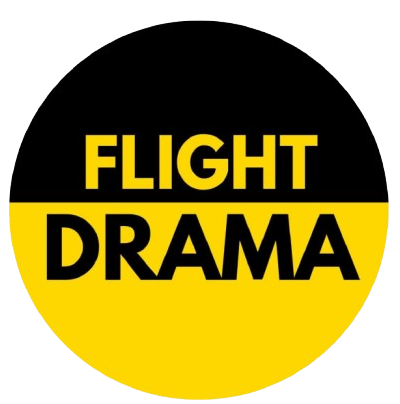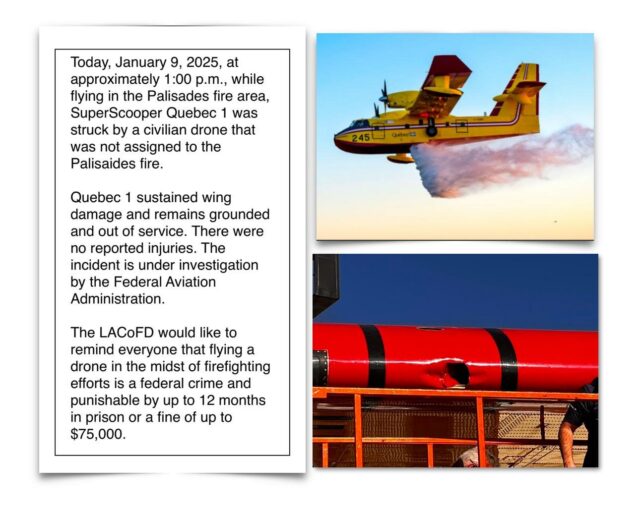Yesterday, the 9th of January 2025, a Canadian firefighting aircraft was grounded after it was struck by a small civilian drone.
The aircraft is a Canadair CL-415, an amphibious aircraft known as the Super Scooper. The twin-engine, high-wing aircraft can fly at relatively low speeds in gusty conditions, allowing it to come in closer to forest fires than most aircraft. The CL-415 has an updated cockpit, improvements to the aerodynamics and an updated water-release system. The upgraded turboprop engines have been placed closer to the fuselage, with winglets added to improve the directional stability caused by the repositioning of the engines. The CL-415 can “scoop” up to 6,140 litres (1,620 US gallons) of fluid from a nearby water source to drop directly onto a fire.
The aircraft, referred to as Quebec 1, is one of two aircraft from the Quebec Service Aérien Gouvernemental which were sent to California along with pilots and technical teams. The day before, Canadian Prime Minister Justin Trudeau posted a video of one of the aircraft in action over the California fires, calling it (rather cleverly I thought) an example of neighbours helping neighbors.
Neighbours helping neighbors. 🇨🇦🇺🇸pic.twitter.com/qRuEsu31T0
— Justin Trudeau (@JustinTrudeau) January 9, 2025
But hours later, the Los Angeles Fire Department reported that Quebec 1 had been struck.
Super Scooper Quebec 1 was struck by a civilian drone that was not assigned to the Palisades Fire, causing damage which resulted in the aircraft being grounded and unable to fly until any needed repairs are made.

All firefighting aircraft were grounded for 30 minutes as they ensured that the airspace was clear. Quebec 1 landed safely. The drone was almost certainly destroyed in the impact.
The Palisades Fire, one of the most destructive wildfires in Los Angeles history, has resulted in the destruction of approximately 5,300 structures and significant damage to over 10,000 buildings, displacing nearly 180,000 residents and leading to at least 10 fatalities as firefighters continue to battle the blaze fuelled by extreme weather conditions and challenging terrain
A representative of California’s state firefighting agency commented: “We all know how fast a fire can travel in half an hour. So this is a seriously dangerous situation because now that fire is able to go a little more unchecked.”
As of writing, it is not clear when Quebec 1 will be able to return to service although thankfully, the outer skin does look to be quickly repairable if there’s no further damage inside. Additionally, the Quebec Public Security Minister has confirmed that two additional water bombers are on their way to help get the fires under control.

The media and aviation sites are reporting that the aircraft QUE245, registered in Canada as C-GQBG, is the aircraft that was struck. However, a photograph shared on social media, which appears to show the same damage, clearly has the callsign QBE on the wing. FlightRadar24 does not show either registration as having flown since the incident.
Under California Code, Penal Code – PEN § 148.2, anyone who wilfully interferes with the lawful efforts of firefighters is guilty of a misdemeanour, which holds a maximum penalty of six months in jail and/or a fine of not more than $1,000. However, yesterday’s FAA statement clarifies that this is considered a federal crime, as they interfered with firefighting efforts on public lands. This would increase the possible sentence to 12 months in prison. In addition, the FAA can impose a civil penalty of up to $75,000 against any drone pilot who interferes with wildfire suppression when temporary flight restrictions are in place.
The Federal Aviation Administration confirmed that no drone operations were authorised in the fire zone except those directly involved in firefighting operations. Yet social media is filled with aerial footage of the fires taken this week, each video representing another illegal drone flight through restricted airspace.



